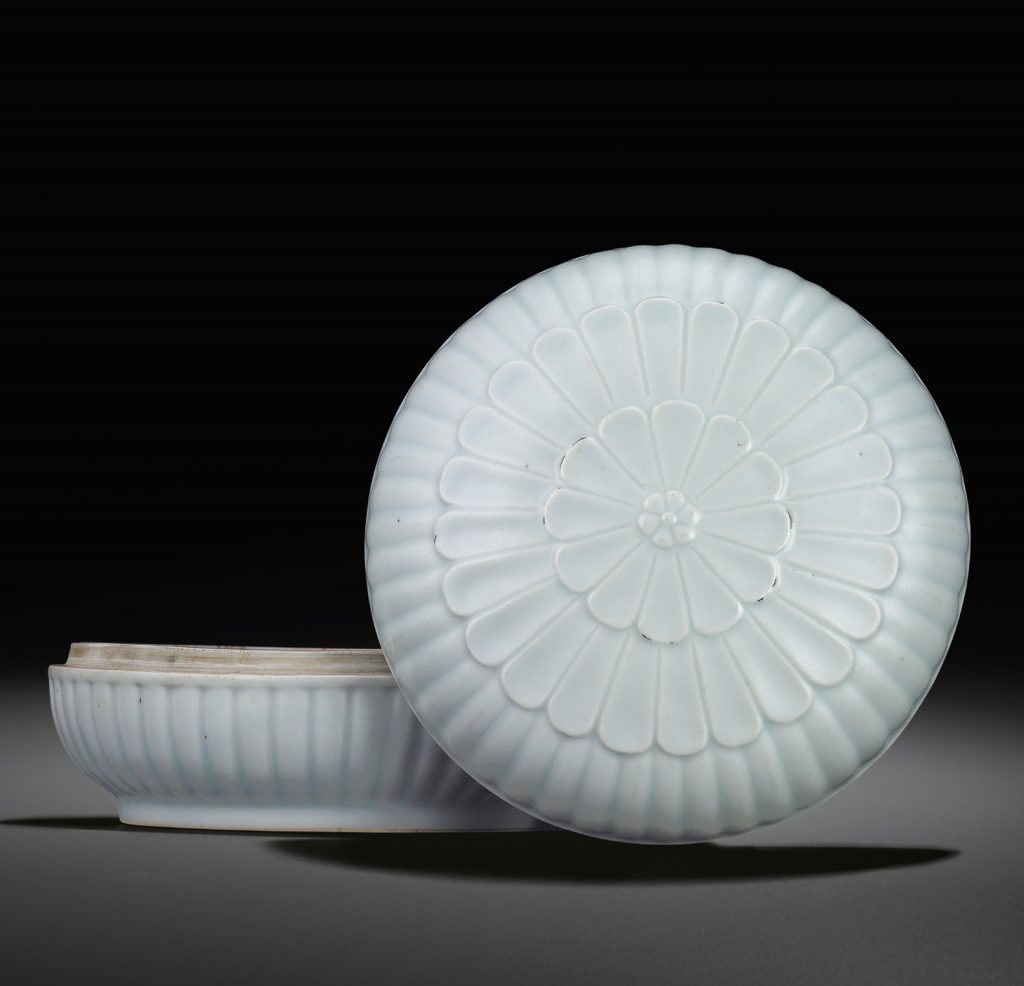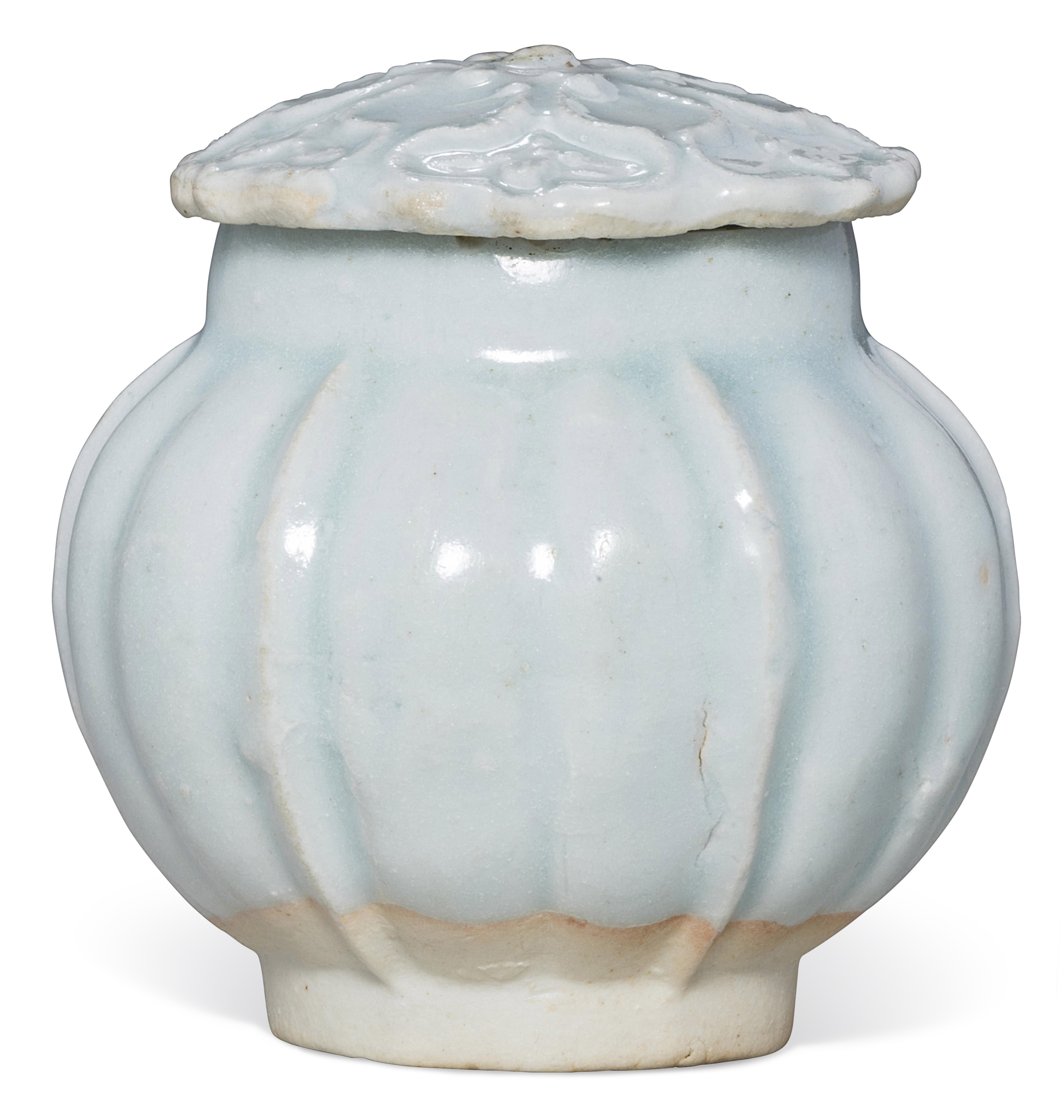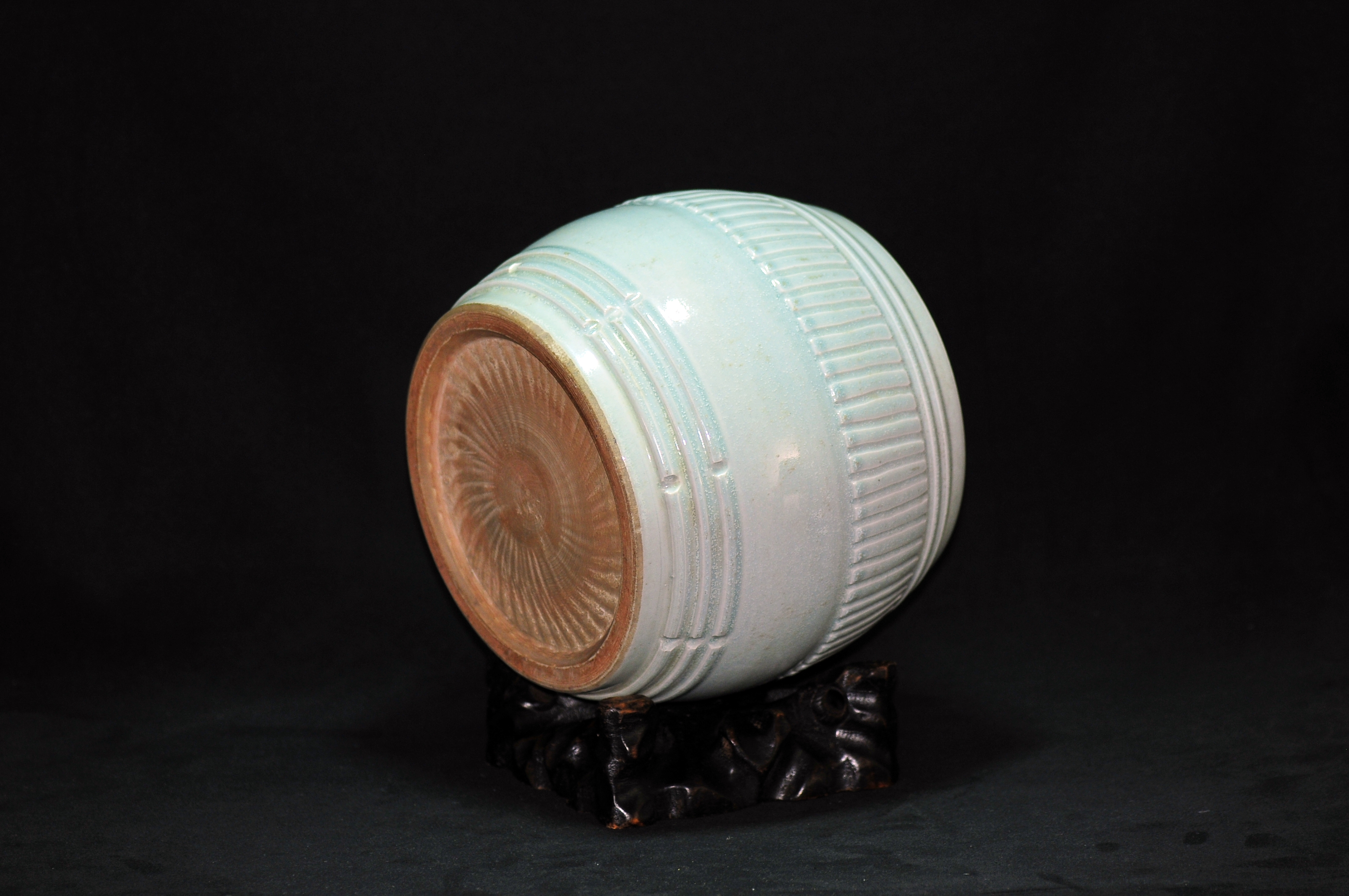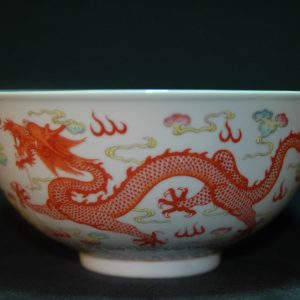Description
宋/遼 青釉玄紋瓜棱罐
湖田窑影青釉玄纹盖罐
参考:佳士得
26 11月 2013 | 现场拍卖 3263
重要中国瓷器及工艺精品
拍品 3500 清早 白釉菊瓣纹盖盒
ANOTHER PROPERTY
A WHITE-GLAZED CHRYSANTHEMUM-SHAPED BOX AND COVER
QING DYNASTY, EARLY 18TH CENTURY

成交价 HKD 137,500
估价 HKD 80,000 – HKD 120,000
A WHITE-GLAZED CHRYSANTHEMUM-SHAPED BOX AND COVER
QING DYNASTY, EARLY 18TH CENTURY
细节
A WHITE-GLAZED CHRYSANTHEMUM-SHAPED BOX AND COVER
QING DYNASTY, EARLY 18TH CENTURY
The slightly domed cover is finely moulded with four concentric rings of chrysanthemum petals radiating from a stylised flowerhead in the centre, and the fluted box is moulded with a single band of petals. It is covered with a white glaze of faint bluish tinge, and the base with a transparent glaze covering an apocryphal Xuande six-character mark.
6 5/16 in. (16 cm.) diam., Japanese wood box
来源
Collection of Reijuin, Chief Abbot of the Daitsuji Temple in Nagahama, Japan
Sold at a dealer’s auction in Japan in 1924, no. 90
状况报告
We have sought to record changes in the condition of this piece acquired after its initial manufacture.
– There are some minor glaze flakes and two areas of restoration to the mouth rim of the box, measuring approx. 5.5 cm and 4 cm long respectively.
拍品专文
Several boxes of the same design and size have been recorded. One was included in Exhibition of Far Eastern Ceramics from the Ataka Collection, Kyoto National Museum, 1978, no. 80. The second box was in the J.M. Hu Collection, sold at Sotheby’s New York, 4 June 1985, lot 4. Another very similar box, in the Avery Brundage Collection, is illustrated by Rene-Yvon Lefebvre d’Argence in Chinese Ceramics in the Avery Brundage Collection, 1967, pl. LV1, B.
All the above examples were catalogued as dating to the Xuande period but in the absence of similar excavated examples, it is difficult to date this group to the Xuande period with any degree of certainty.
参考:佳士得
18 9月 2014| 现场拍卖 2872
中国瓷器及工艺精品
拍品 892 清康熙 矾红云龙瓜棱菊瓣百條纹青釉罐 官字款
A RARE COPPER-RED-DECORATED AND CELADON-GLAZED ‘HUNDRED RIB’ JAR, GUAN
KANGXI PERIOD (1662-1722)

成交价 USD 149,000
估价 USD 80,000 – USD 100,000
A RARE COPPER-RED-DECORATED AND CELADON-GLAZED ‘HUNDRED RIB’ JAR, GUAN
KANGXI PERIOD (1662-1722)
The jar is well potted and relief-decorated around the sides with a band of ‘one hundred’ ribs glazed in pale celadon below the rounded shoulder decorated with two copper-red dragons emerging from behind scrolling clouds delicately incised under the pale blue-tinged white glaze. The concave base is unglazed.
10 3/8 in. (26.4 cm.) diam.
来源
Dr. and Mrs. William L. Corbin Collection; Christie’s New York, 16 September 2010, lot 1407.
展览
On loan: Portland Art Museum, 1 June 2006 – 22 June 2010; exhibited 2007-2010.
拍场告示
Please note that a party with a financial interest, who has knowledge of the reserve, may be bidding on this lot.
状况报告
We have sought to record changes in the condition of this piece acquired after its initial manufacture.
-appears to be in overall good condition
-the mouth rim has been slightly buffed
-small irons spots, pinprick holes and light fritting
-shallow chips and firing cracks to foot rim
拍品专文
A very similar jar, in the collection of W.T. Walters, is illustrated by S.W. Bushell in Oriental Ceramic Art, New York, 1980 ed., p. 75, fig. 107.
参考:The Cleveland Museum of Art
Circular Box: Qingbai Ware
1200s-1300s
China, Southern Song Dynasty (1127-1279) – Yuan Dynasty
(1271-1368)
Glazed porcelain



Diameter: 5.2 cm (2 1/16 in.)
Bequest of Elizabeth B. Blossom 1972.256
HIDEEXHIBITION HISTORY
CMA Extensions Exhibition: “Science Within Art”, CMA February 13-April 20, 1980, Beachwood Museum, May 10-June 8, 1980
“Year in Review 1972” Bulletin of the Cleveland Museum of Art 60, no. 3 (Mar., 1973): 114, cat. no. 296
Year in Review: 1972. The Cleveland Museum of Art (organizer) (February 27-March 18, 1973).
Science within Art. The Cleveland Museum of Art (organizer) (February 13-April 20, 1980).
Collection: China – Song Dynasty
Department: Chinese Art
Type of artwork: Ceramic
Medium: Glazed porcelain
Credit line: Bequest of Elizabeth B. Blossom
参考:苏富比
PROPERTY FROM THE COLLECTION OF DR. AND MRS. GREGORY F. SULLIVAN
852 元末 / 明初 龍泉窰青釉百條紋大罐
A LARGE ‘LONGQUAN’ CELADON-GLAZED RIBBED BALUSTER JAR,
LATE YUAN / EARLY MING DYNASTY



Estimate:3,000 – 5,000 USD
Lot sold:10,625USD
Description
A LARGE ‘LONGQUAN’ CELADON-GLAZED RIBBED BALUSTER JAR
LATE YUAN / EARLY MING DYNASTY
元末 / 明初 龍泉窰青釉百條紋大罐
Height 10½ in., 26.7 cm
拍品狀況
The jar has two rim chips (each with an associated crack), as well as further cracks throughout and chips to the foot.
口沿見兩磕且各帶裂,器身均可見裂,足部有磕。
参考:Sotheby’s
CHINA / 5000 YEARS 博古五千
PROPERTY FROM THE ‘ART OF TOMORROW’ COLLECTION
藝創明天收藏
363
A LONGQUAN CELADON BOWL MING DYNASTY
明 龍泉青釉盌


Estimate:
50,000 – 70,000 HKD
Description
PROPERTY FROM THE ‘ART OF TOMORROW’ COLLECTION
A LONGQUAN CELADON BOWL
MING DYNASTY
藝創明天收藏
明 龍泉青釉盌
13.9 cm, 5½ in.
参考:苏富比 21
利國偉爵士瓷器玉雕雅藏
清十九世紀 粉青釉長頸瓶


20,000 — 30,000港幣
拍品已售 62,500 港幣 成交價 (含買家佣金)
拍品詳情
清十九世紀 粉青釉長頸瓶
51.7 公分,20 3/8 英寸
利國偉爵士瓷器玉雕雅藏
2019年11月28日 | 上午 10:00 HKT
香港
参考:佳士得 拍賣 15961
重要中國瓷器及工藝精品
香港|2018年11月28日
拍品2959
清康熙 天藍釉百條缸
KANGXI PERIOD (1662- 1722)

清康熙 天藍釉百條缸
成交總額
HKD 350,000
估價
HKD 300,000 – HKD 500,000
清康熙 天藍釉百條缸
11 5/8 in. (29.5 cm.) diam., Japanese wood box
來源
日本私人珍藏, 於1980年代入藏
拍品專文
此缸縮頸矮直沿,圓肩,束腹下部至底,外壁飾直柳條紋,內外皆施天藍釉,外底無釉。 天藍釉色淡雅悅目,似天青之藍,故其名。始見宣德朝,但至康熙朝才受到重視,多用於文房用具,器物種類多見於精巧小件。 此缸形制較大,造型典雅,釉色素雅,為康熙天藍釉大器之代表。
與此缸相比,造型、裝飾、尺寸及釉色幾乎相同之一例藏於北京故宮博物院,載於《故宮博物院藏古陶瓷資料選萃- 卷二》,
北京,2005年,頁127,編號105。另一相似例為中國國家博物館館藏,載於《中國國家博物館館藏文物研究叢書- 瓷器卷- 清代》,上海,2007年,頁48,編號30。 私人收藏中,有一例為胡惠春舊藏,於1985年6月4日售於紐約蘇富比,拍品29號;另一例附紐約J. J. Lally & Co之來源,售於香港蘇富比,2017年4月5日,拍品1111號。
参考:佳士得拍賣 15706
中國瓷器及工藝精品
紐約|2018年9月13日 – 14日
拍品1321
高麗十二世紀 青瓷竹節紋玉壺春瓶
GORYEO DYNASTY, 12TH CENTURY

高麗十二世紀 青瓷竹節紋玉壺春瓶
成交總額
USD 68,750
估價
USD 25,000 – USD 30,000
高麗十二世紀 青瓷竹節紋玉壺春瓶
14 ½ in. (36.8 cm.) high
拍品專文
Perhaps used as a flower vase, this sophisticated vessel more likely served as a bottle for dispensing wine at an elegant gathering during Korea’s Goryeo dynasty 高麗時代 (AD 918–1392), an era of supreme artistic refinement. With its decoration suggesting a cluster of bamboo stalks, it perfectly demonstrates the transformation of a Chinese vessel type to meet Korean aesthetic preferences.
The celadon wares 青瓷, Korea’s best-known ceramics, exemplify the refined sensibilities of Goryeo culture. Though numerous kilns produced celadon wares, the very best pieces—which were used by the royal court, the aristocracy, and wealthy Buddhist temples—came from kilns in Gangjin (in South Jeolla province) 全羅南道康津郡 and in Bu’an (in North Jeolla province) 全羅北道扶安郡, areas in the southwestern part of the peninsula that are rich in fine stoneware clays. Vessels with molded, incised, or carved decoration, such as this exquisite bottle, typify twelfth-century wares, while ones with designs inlaid in black and white slips 化妝土 epitomize those of the thirteenth and fourteen centuries (the inlay technique known in Korean as sanggam gisul 鑲嵌技術). As evinced by this elegant bottle, Goryeo-period clients favored vessels in sculptural form, the forms characteristically suggesting bamboo shoots or clusters, lotus blossoms, ripe melons, calabash gourds, and open blossoms, among others. Korean celadon glazes tend to be more transparent and also more bluish green than those of contemporaneous Chinese celadons. The finest Korean celadons rival their Chinese counterparts in terms of both artistic sophistication and technical achievement. In fact, a thirteenth-century Chinese connoisseur, one Taiping Laoren 太平老人, ranked Korean celadons “first under heaven” 天下第一, including them on a list with such other “firsts” as the wines of the palace, the inkstones 硯台 of Duanxi 端溪 (端硯), the peonies of Luoyang 洛陽, and the tea of Fujian 福建.
Though often compared to Longquan celadon wares 龍泉窯, vessels of this type were made in the twelfth century and thus are earlier than the visually similar Longquan bottles, which typically date to the thirteenth century. In fact, such Korean bottles likely were inspired by Chinese imperial Ru ware 汝窯, like the rare bottle in the British Museum (1978,0522.1; see: Jessica Rawson, The British Museum Book of Chinese Art, London: British Museum Publications, 1992, fig. 166). Lacking decoration, the earliest such Korean celadon bottles—the one in the Henderson Collection in the Harvard Art Museums (1991.542), for example, or that in the Gompertz Collection in the Fitzwilliam Museum at Cambridge University (C.419-1984)—are very much in the Chinese mode; with their taste for sculptural forms, however, Korean potters soon transformed such bottles by embellishing their surfaces with wide, vertical ribs which they finished to resemble stalks of bamboo, imparting a uniquely Korean interpretation. In addition to long-necked bottles, ewers also occasionally were decorated in similar manner; see, for example, the ewer in New York’s Metropolitan Museum of Art (1996.471), the ewer-and-basin set in the National Museum of Korea, Seoul (Deoksu-378), and the calabash-shaped ewer in the Asian Art Museum, San Francisco (B64P58).
Several museum collections include bottles of similar size, shape, style, and appearance. The very best such bottles, however, are those in the Lee’um Samsung Museum, Seoul, and the Museum of Fine Arts, Boston (11.1819; see: Jane Portal, Arts of Korea, Boston: Museum of Fine Arts Publications, 2012). In addition, Godfrey Gompertz illustrated a closely related example in his classic Korean Celadon, the first scholarly book on the subject in English, the bottle at that time in the collection of Hyŏng-min Kim (see: Godfrey St. G. M. Gompertz, Korean Celadon, and Other Wares of the Koryŏ Period, London: Faber and Faber, 1963, pl. 27).
Robert D. Mowry 毛瑞
Alan J. Dworsky Curator of Chinese Art Emeritus,
Harvard Art Museums, and
Senior Consultant, Christie’s
哈佛大學藝術博物館亞洲部榮譽主任暨佳士得高級顧問
参考:佳士得 拍賣 16314中國藝術:紐約夏季網上拍賣網上|2018年 7月 11 – 18日
拍品 12
元 青白釉小蓋罐
YUAN DYNASTY (1271-1368)

元 青白釉小蓋罐

元 青白釉小蓋罐

元 青白釉小蓋罐

元 青白釉小蓋罐
估價: USD 1,000 – USD 1,500
(CAD 1,326.80 – CAD 1,990.20)
成交價: USD 2,750
The lobed jar is covered with a glaze of pale bluish-green tone, stopping neatly above the foot, and the similarly glazed cover is molded as a six-petaled flower.
3 1/4 (8.3 cm.) in. high, Japanese wood box
参考:佳士得 拍賣 16723
佩吉及大衛‧洛克菲勒夫婦珍藏:旅遊及美國文物
紐約|2018年5月10日
拍品953 高麗王朝 青釉瓜棱灯笼尊
A KOREAN FLUTED VASE
JOSEON DYNASTY (19TH CENTURY)

成交總額
USD 68,750
估價
USD 4,000 – USD 6,000
A KOREAN FLUTED VASE
JOSEON DYNASTY (19TH CENTURY)
The fluted body is set with short neck on a short circular foot, applied with white glaze throughout except the center of the base
7 ¾ in. (19.5 cm.) tall
來源
Gallery Kapitan, Tokyo, Japan, 1985
参考:利國偉爵士瓷器玉雕雅藏
21 清十九世紀 粉青釉長頸瓶

估價 20,000 — 30,000 港幣
拍品已售 62,500 港幣 成交價 (含買家佣金)
51.7 公分,20 3/8 英寸
参考:佳士得
拍賣 5765
中國陶瓷、工藝精品與紡織品
倫敦南肯辛頓|2014年11月7日
拍品412 清 康熙 瓜棱龙凤纹罐
A BLUE AND WHITE MOULDED ‘DRAGON AND PHOENIX’ JAR
KANGXI PERIOD (1662-1722)

成交總額
GBP 3,000
估價
GBP 1,500 – GBP 2,500
A BLUE AND WHITE MOULDED ‘DRAGON AND PHOENIX’ JAR
KANGXI PERIOD (1662-1722)
The jar is moulded to the exterior with vertical ribs and four flat roundels which are alternately decorated with a dragon chasing a flaming pearl and a stylised phoenix, all between key fret and ruyi borders. The base with a floral spray.
8 in. (23 cm.) high

![[临渊阁]天地一家春](https://www.antiquekeeper.ca/wp-content/uploads/2023/03/cropped-Asian-Art-Wallpaper-Painting3-6-3.jpg)
























































